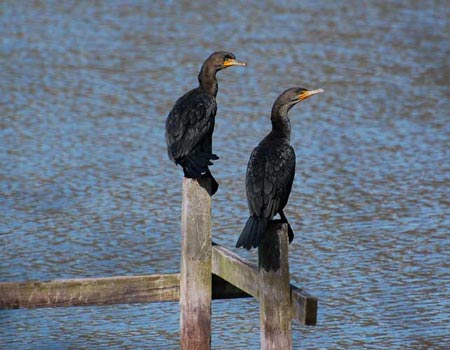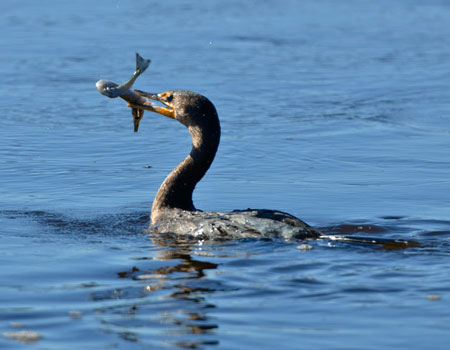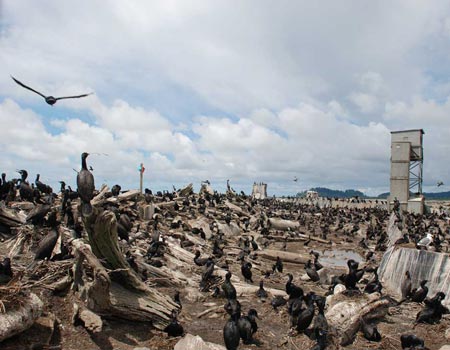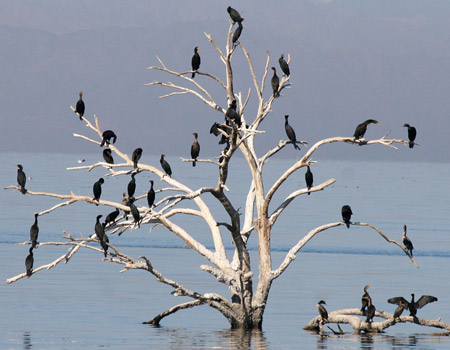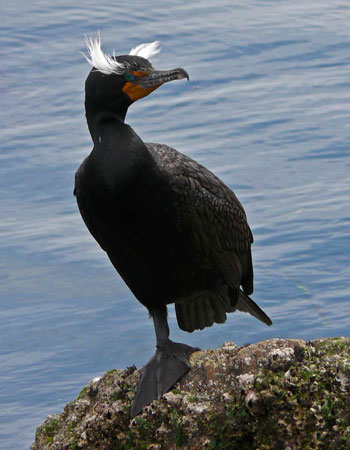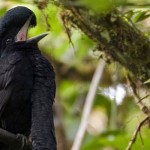I’ve been obsessed with cormorants for several years now, ever since I wrote my interdisciplinary master’s thesis on the seabirds. My studies took me all over North America, to four other continents, and almost to bankruptcy court trying to fund all the travel and research. Now, aside from the occasional boat trip to observe a local rookery, my involvement is limited to a Google news alert set to the keyword “cormorant.” Nearly every morning I get a link to a newspaper or magazine article by or regarding someone, somewhere in North America, arguing bitterly about what to do with the bird.
In case the hubbub has escaped your notice, let me sum it up for you. For the last thirty years or so, populations of double-crested cormorants (Phalacrocorax auritus) have been blossoming in many parts of North America. Although many people herald the cormorant boom as a success—an indicator of improving environmental health—all sorts of other folks are in a tizzy about it. For example, near my town of Mystic, Connecticut, otherwise nature-loving people want to kick cormorants off South Dumpling Island, a three-acre, uninhabited bump in eastern Long Island Sound. About 500 cormorants live there now, having only moved in (or perhaps back) less than ten years ago. Members of the Avalonia Land Conservancy, which owns South Dumpling, observe that the birds’ feces are slowly killing the trees and ground cover, and they fear that soil erosion will soon follow. They’re also worried that the cormorants are pushing other birds, such as the snowy egret, off the island. Anne H. Nalwalk, who recently stepped down as president after leading the Conservancy for twenty-two years, once said: “We’d rather see egrets than a bird that’s destroying all the vegetation.”
The conservancy works with a local marine-science educational group called Project Oceanology, which for the last four years or so has landed instructors and students on South Dumpling to test various cormorant deterrents. They’ve tried anti-erosion mats, snow fences, and nets draped over the trees. Their actions are backed, informally, by at least one local commercial fisherman, who approves of any measure to reduce the number of cormorants in Long Island Sound because he blames the birds for a drop in bluefish and flounder stocks.
Throughout the United States and Canada, pockets of citizens want to reduce cormorant populations they deem overabundant, for the same reasons: destruction of vegetation, unfair competition with more-valued species, and overindulgence in fish. Occasionally, there are claims that cormorants negatively affect water quality or public health, or just that their guano smells nasty. But the most vehement complaints are about fish—primarily from freshwater charter fishermen and fish farmers. In 1998, a bunch of charter fishermen turned vigilantes stormed onto Little Galloo Island in eastern Lake Ontario, trampling and shooting about 2,000 cormorants in violation of federal law. (It’s a crime to kill migratory birds without a permit.) They were eventually brought to justice, but another group that killed more than 500 cormorants two years later on Little Charity Island in Saginaw Bay, Michigan, never was.
So great was the public outcry against the birds that the U.S. Fish and Wildlife Service (USFWS) felt compelled to draft a new cormorant management plan. During the grueling, multiyear analysis and public-comment period that followed, many voices pushed for stringent management to reduce cormorant numbers. Some wanted to establish hunting seasons—even though nobody eats cormorants. Others, including the National Audubon Society and the Humane Society of the United States, rallied to the cormorants’ defense, citing a lack of scientific evidence that cormorants actually damage fish or wildlife populations. In 2003, the USFWS settled on expanding the rights of citizens and managers to deal with cormorants, handing over most of the decision making to selected local agencies. (The service took a similar route in 2006 to tighten management of burgeoning Canada geese, the only birds that provoke anywhere near as much irritation as cormorants for their fouling of lawns and parks.) Today, in thirteen states, aquaculture producers may shoot cormorants feeding on their private ponds, and they may call on government wildlife managers to shoot birds on nearby roosts. Local managers in twenty-four states can suffocate cormorant eggs with oil; destroy their nests; or kill cormorants that threaten public resources, such as wild fish, plants, and other birds’ nesting areas.
Under the new rules, individuals and states are permitted to kill a total of 160,000 cormorants each year. An average of about 40,000 cormorants are reported killed each year—perhaps 2 percent of North America’s population. That figure does not include tens of thousands of eggs oiled annually. Biologists cannot agree on the long-term ecological effect of the culling. Some have pointed out that managers who enter nesting grounds to cull or oil eggs often end up doing more damage to other bird species than the nesting cormorants do in the first place. Linda R. Wires, a conservation biologist and cormorant expert at the University of Minnesota in St. Paul, who has been deeply involved in the USFWS’s investigations, told me: “At the heart of this issue is nearly a zero tolerance for cormorants. It’s a witch hunt.”
Depending on your chosen taxonomy, there are between twenty-seven and thirty-eight extant species of cormorants, all closely related to pelicans, frigate birds, and anhingas. They live around the globe in colonies bordering salt- and freshwater.
There is the flightless cormorant of the Galápagos Islands and the pygmy cormorant of eastern Europe. The large and nearly flightless spectacled cormorant of the western Aleutian Islands was driven extinct in the mid-nineteenth century by natives and explorers, who ate the seabird’s meat and harvested its eggs. A few cormorant species are called shags, lending themselves to all sorts of sexual puns. Then there is the great cormorant. Like the double-crested cormorant in North America, it has made a huge comeback in western Europe, spurring familiar outcries from fishermen and property owners who have nicknamed it “the black plague.”
As a group, cormorants primarily eat fish, but will also eat crustaceans, mollusks, and small amphibians. Most species prefer to hunt in coastal shallows, but many can dive more than 100 feet underwater. (The Crozet shag of the Southern Ocean has been recorded at the impressive depth of 475 feet.) Using their beaks to gather sticks, seaweed, fishing line, ribbons, and other random items, cormorants build their nests in trees, or on rocks, dirt, or sand. The adults have no song or call, only a hiss or a piggy grunt, something like the creak of an old door hinge. The young in the nest issue a shrill, high-pitched cry for food.
Today, six species of cormorants live in North America. By far the most prevalent in the U.S., and the only one found appreciably inland, is the double-crested cormorant, which gets its name from two tufts of feathers that appear on the heads of both sexes during breeding season. Double-crested cormorants nest in forty-three states, every Canadian province, Cuba, and the Bahamas. During migrations or winter roosting they spend time in every state except Hawaii. They travel as far north as Alaska and Labrador and as far south as the Yucatan Peninsula.
So what does it mean for a species as cosmopolitan as the double-crested cormorant to be “overabundant”? How many cormorants are “too many”? Much of the debate about managing the bird swirls around whether it’s native to a particular region and how many once lived there—facts that have been difficult to pin down. Wires and Francesca J. Cuthbert, an avian biologist also at the University of Minnesota, made a recent attempt, examining archaeological records and naturalists’ accounts, among other sources. Before Europeans became a major presence, Wires and Cuthbert conclude, double-crested cormorants lived throughout much of their current North American range, usually in populations far greater than today. For example, after birdwatching near Natchez, Mississippi, in December of 1820, John James Audubon reported: “We saw to day probably Millions of those . . . Cormorants, flying Southwest—they flew in Single Lines for several Hours extremely high.” Numbers like that simply don’t exist today.
To be sure, it is often impossible to tell whether a specific area was historically home to the birds. Cormorants might well have nested on South Dumpling Island at the time of European contact: explorers’ accounts and archaeological records show nests within a hundred miles, and an 1847 nautical chart identifies a Cormorant Reef and a Cormorant Rock within five miles. Cormorant Cove lies twenty miles away. None of that proves they nested at South Dumpling—or at the other locations—but clearly cormorants are regional natives.
As with most animal species, the population history of double-crested cormorants in North America has been shaped by human activity. Native Americans on both coasts ate cormorants and their eggs. Early European settlers didn’t seem to eat much cormorant, but they did use the bird’s meat for fish bait. By the nineteenth century, most seabird populations in New England and Nova Scotia had plummeted. Settlement and industry had encroached on island nesting areas. People gathered eggs for food, and shot all kinds of seabirds for meat, hat feathers, sport, and to keep them from eating marketable fish. Men pegged cormorants, specifically, as fish stealers. Harrison Flint Lewis, author of the first North American doctoral thesis on cormorants, wrote in 1929: “The history of the Double-crested Cormorant during the latter part of the nineteenth century and the first quarter of the twentieth is largely a history of persecution and of the gradual abandonment of one breeding-place after another.” By that time, cormorants no longer bred anywhere in New England.
Cormorant populations made a brief recovery during the first half of the twentieth century as people moved off islands to seek better opportunities and built new seabird habitat—in the form of reservoirs, dock pilings, and bridges. But as cormorant numbers increased, so, again, did their persecution. John Steinbeck and Edward F. Ricketts, recounting a visit to the Baja Peninsula, facetiously summed up the prevailing attitude in their 1941 book, The Sea of Cortez:
[T]here had been light gunfire on the cliffs, where several men were shooting at black cormorants; and it developed that everyone in Cape San Lucas hates cormorants. They are the flies in a perfect ecological ointment. . . . They dive and catch fish, but also they drive the schools away from the pier out of easy reach of the baitmen. They are considered interlopers, radicals, subversive forces against the perfect and God-set balance on Cape San Lucas. And they are rightly slaughtered, as all radicals should be.
DDT and other egg-thinning pesticides, introduced after World War II, intensified the devastation, and over the next two decades cormorant populations sharply declined again continent-wide. By 1969, the largest colony ever recorded in North America—perhaps a quarter million breeding pairs on an island off Baja California—had fallen to just 5,000 pairs. (It eventually hit zero and now probably numbers fewer than a thousand pairs.)
Then came 1972, one of the few good years in recent cormorant history. The National Audubon Society listed the double-crested cormorant as a species of special concern. The state of Wisconsin declared cormorants endangered and began building nesting structures to help them return. Lawmakers banned the use of DDT, and Congress signed a revised Migratory Bird Treaty Act that put cormorants under federal protection.
Cormorant populations have since rebounded, thanks in part to conservation measures and to people’s inadvertent creation of ideal cormorant habitat near ample food supplies. For example, at the mouth of the Columbia River, the Army Corps of Engineers enlarged and stabilized an island with dredge spoil in the early 1980s. Today East Sand Island in Washington State hosts the continent’s largest cormorant colony (albeit with fewer than 14,000 breeding pairs), surely because it is a protected, mammal-free nesting habitat near migrations of wild and farmed salmon and steelhead. The cormorants, along with Caspian terns, feed heavily on thirteen endangered salmonid stocks—a legitimate cause for concern, though it must be remembered that people both caused the salmon’s problems and built the cormorants’ base of operations. Now managers are trying to lure the terns to artificial islands being built for them on distant lakes, and may attempt the same for the cormorants.
Meanwhile, catfish and baitfish aquaculture has been rapidly growing since the 1960s, particularly in the southeastern U.S., directly on the cormorants’ migration route. Open aquaculture ponds provide winter or year-round homes with food aplenty. Many of the same cormorants breed and summer up north in the Great Lakes. That’s the area with the greatest growth in cormorant populations, and the center of a good deal of the controversy. It’s also the area where Wires and Cuthbert’s evidence for cormorants’ former abundance is the most anecdotal and inconclusive. The population growth in the Great Lakes—from approximately 90 breeding pairs in 1970 to nearly 115,000 in 2000—was fueled, ironically enough, by government managers stocking the region’s waters for recreational angling, often using fish raised in the southeastern aquaculture ponds.
Great Lakes cormorant numbers seem to be holding steady today; indeed, recent nest counts suggest that cormorant populations nationwide are beginning to plateau, even to decrease in a few areas. If so, they’ve likely stopped far short of achieving numbers that existed throughout much of North America before European settlement.
It is relevant that the National Audubon Society did not choose the double-crested cormorant for its logo: Anne Nalwalk is not alone in her preference for egrets. In my town you can buy a little wood sculpture of a gull, but not a tchotchke cormorant. Gulls have made a huge resurgence alongside cormorants, thanks to the everlasting food supply at landfills and littered beaches. They eat trash and plenty of people still love them.
Cormorants are black. The effect of color associations on an animal’s popularity among Americans is debatable, but in Louisiana I’ve heard cormorants called “n— birds.” Cormorants have no pretty song, no graceful step. There has been no movie or television show to anthropomorphize the bird, no cormorant Bambi or Flipper. There are a couple of positive small-press children’s books, but the only major story featuring the bird is an award-winning novel by Stephen Gregory, calledThe Cormorant, in which the titular bird is literally satanic. It ruins a man’s life, tearing off the face of his pet cat and causing the fiery death of his son. In fact, the bird has had a poor reputation in literature beginning with the Bible, where it is described as unclean and connected with death. In Paradise Lost, Milton portrays Satan himself breaking into Paradise and sitting on the Tree of Life “like a cormorant.”
The adjective “cormorous” used to mean greedy, insatiable, ravenous. (Notice the raven here.) In four plays, Shakespeare used the word “cormorant” as a synonym for “voracious.” Yet the charge that cormorants have an unusually large appetite is misplaced. Despite the notorious difficulty of determining exactly what seabirds eat, most studies show that on average, a double-crested cormorant eats at most one pound of fish per day. That’s much less in absolute terms than a pelican eats and a similar percentage of body weight. Pelicans, though, remain generally beloved despite growing populations. Cormorants may be easy scapegoats (another animal with an image problem) simply because their hunting is so visible to people. The birds often forage by docks and in bays, and they can eat memorably large fish for their size, slurping down eels and other species longer than two feet. Yes, cormorants eat fish, but their populations would crash naturally in a region that didn’t have enough fish to eat.
Cormorants’ effect on wild commercial stocks remains unclear. Admittedly, they could be eating fish that marketable species depend upon; and a very large population could conceivably put a dent in a commercial or sport fish stock. But most research shows that cormorants don’t focus on the wild species that people like to eat. Instead, they opportunistically feed on small schooling fish, “trash fish,” whatever is available. Cormorants’ effect on the aquaculture industry, however, is painfully obvious: a dense flock can destroy a harvest, and cormorants are estimated to cost the catfish industry in Mississippi alone between $10 million and $25 million dollars annually.
The cormorant situation on my local South Dumpling Island is minor compared with that of the Great Lakes, the Mississippi Delta, and the mouth of the Columbia River, but it is representative of the issue’s complexity. The popular view of how cormorants affect Long Island Sound’s commercial fish is well put by Brae Rafferty, a senior instructor at Project Oceanology and a veteran of nearly three decades on the sound. He says: “When you’re out on the water all the time and seeing the birds, you think, ’They’ve got to be feeding on something.’ The winter flounder aren’t coming back. I’ve seen cormorants eating flounder, so between them and the seals there’s got to be some impact.”
Anne Nalwalk isn’t as concerned about the fish; it’s the look of South Dumpling that bothers her. She’s also aware that her objection to the cormorants is, as she says, “in the eye of the beholder.” Her concern is not based on the local environment’s true carrying capacity, but rather on what scientists call “wildlife acceptance capacity.” Her opinion derives primarily from cultural factors: learned aesthetics, negative portrayals in the media, and a nostalgia for the way things used to look within her memory. And there’s the rub with cormorants. Sure, their numbers are way up compared with what they were during the mid-twentieth-century DDT spree. But if their estimated populations before Europeans arrived are the baseline, they’ve simply paused partway on the long road to recovery.
People, not seabirds, have done the real damage to the fisheries and ecosystems of the coasts and the Great Lakes, through overfishing, introduced species, and pollution. The money spent trying to manage cormorants—which taxpayers will need to cough up indefinitely, unless we wipe the birds out forever—could be much better spent to reduce coastal pollution; to secure conservation land and marine preserves; and to help aquaculture producers develop new bird-smart practices and fishermen develop sustainable fisheries. Let’s take the bird off the guano list. Maybe Disney could come out with a new film, something between The Little Mermaid and The Ugly Duckling. I’ll be watching for it in a Google alert.

